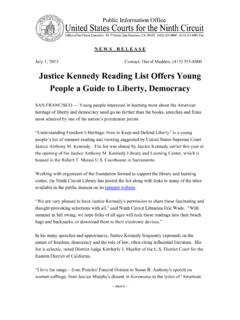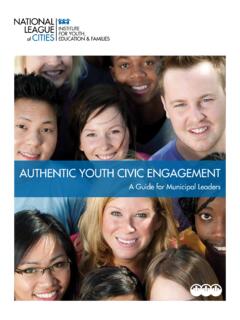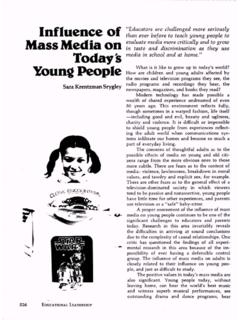Transcription of GUIDE - Home page | UNICEF
1 PARGUIDEFor every ChildHealth, Education, Equality, ProtectionADVANCE HUMANITYP romoting the Participation, Learning and Action of young PeoplePARGUIDEFor every ChildHealth, Education, Equality, ProtectionADVANCE HUMANITYP romoting the Participation, Learning and Action of young PeopleWriting: Sheila EvansEditing: Gail Hoad, Penelope CampbellGraphics: GH Associates Copyright 2004 United Nations Children's Fund First published by the United Nations Children's Fund,60 Knutsford Boulevard, Kingston 5, Jamaica4 PAR GUIDE7 ContentsWho is this GUIDE For? 7 What is PAR? 8 Definitions10 Types of PAR11 From Educator to Facilitator 13 Promoting an Open Environment14 Troubling Information16 Other Particulars17 PAR Tips19 PAR Tools22 Action Tools36 Action Plans44 Conclusion45 PROMOTING THE PARTICIPATION, LEARNING AND ACTION OF young PEOPLE6 ACKNOWLEDGEMENTSThe United Nations Children's Fund would like to thankJennifer Tiffany and Keiko Goto of Cornell University fortheir technical oversight.
2 Special thanks to the young people from the following government and non-governmentagencies for their invaluable participation: Children First,St. Catherine and Portland AIDS Committees, JamaicaCoalition on the Rights of the Child, Hope WorldwideJamaica, St. James Health Department, Jamaica RedCross Society, and the Western Society for the Upliftmentof GUIDEPROMOTING THE PARTICIPATION, LEARNING AND ACTION OF young PEOPLE7 This book is written for young people and anyone seeking to actively work with youngpeople. This can include adult facilitators, project officers, community or youth organisa-tion workers and others who are in a positionto help and support, encourage and is all about Participator y Action Research what we call PAR.
3 It gives some helpful tips and describes participatoryactivitiesthat you can use to gather information andencourage actionas a result of that good organisations ask questions ofthemselves: What are the issues affecting young people ? Are we really meeting our goals? What more should we be doing? Are we reaching the right young people ? How can we grow? Why are we successful in some areas butnot in others? What are our strengths and weaknesses? PAR can help find answers to these can also bring people from the communitytogether to help themselves. It can deal withsuch questions as: How can we prevent violence in our schools?
4 How can we cut down on teen pregnancy? How can our group help teenagers who areaffected by HIV/AIDS?PAR empowers people to think, see connec-tions they never saw before, and reason. Itdoes these things in ways that are fun andinteresting. The best part is that PAR is prettyeasy and simple, once you know the basicideas. You do not need to be a college gradu-ate to conduct this research, but you do needsome tools and some understanding of how todo people make great PAR are curious, friendly, and ready to you see yourself in this description, youcould be a PAR more you use PAR, the better you becomeat it.
5 The better you become, the more fun it isand the more effective you will be. This bookwill get you started on your way to becoming aPAR star. this GuideWho isfor?PARGUIDEPAR GUIDEPAR is a short way of saying ParticipatoryAction is a way to help peoplehelp themselves. In the process, it can makeyour organisation more interesting and excit-ing, and bring more people into your pro-grammes especially the people you are aim-ing to ser ve. PAR can be used within an organ-isation to strengthen its planning and pro-grammes particularly at the community really understand the ideas behind PAR,look at each word separately: Participatory This means that the people ,who want or need changes made in their sur-roundings or situations, take part in makingthose changes.
6 It also can mean that the peo-ple you want to learn about take an active rolein helping you learn about them. They takepart in the whole This is the part that really makesPAR different from other types of research. It means that at the end of the searching, something happens. The information is notjust recorded, but it moves people to somesort of This is a way to find informationor to answer questions. Part of the word is search, and that is what you are doing searching for information or solutions to is serious business, but that doesn tmean it can t be fun.
7 Just as the work yourorganisation does is not a joking matter, yetyou can have fun doing it, PAR is serious workdone in ways that keep people from beingbored or being afraid to tell what is inside theirheads and hearts. In fact, it is because yourwork is serious that you need tools to make itreach more people , be more effective, andreally result in action. PAR can do these thingsfor is8 Why does PAR focus on young people ? young people are not only tomorrow s leaders,they are today s leaders. It is not only theirpotential that is important, but what they haveto offer NOW! young people see what worksand what does not work in their lives, the livesof their friends and families, in their communi-ties, and in the nation.
8 They have great ideasthat may be more creative than many adults ,who have lost their passion and faith in thepossibility of change. So, young people areper fect to lead this , youth are ignored or not taken serious-ly. PAR can give youth tools to empower them-selves to find real answers to real problems;to establish themselves as serious thinkerswho like to have fun while they think and addition, PAR moves people up the nextstep from talking to action, and mostyoung people can t be bothered withprogrammes that are not estimates there are billion young people aged 10 to 19 inthe world the largest generation of adolescents in histor y.
9 More than four-fifthsof them live in developing countries, likeJamaica and what happens to these youngpeople affects us all. As UNICEF claims in itsbooklet, Adolescence, A Time That Matters (2002): When encouraged to express their opin-ions and feelings, to be assertive and tostand up for what they believe, adoles-cents are more likely to have self-esteemand self confidence and develop theirskills and If given a voice, young people can provideimportant information about conditions atwork or at school,about risks to their ownhealth and their community. They can provide suggestions for change thatadults may not have considered, and theycan play a vital role in researching, moni-toring, evaluation and planning.
10 So, PAR can empower the partici-pants as well as the researchers. It can help develop skills and think-ing processes; and can get youngpeople moving to improve their ownsituations and their THE PARTICIPATION, LEARNING AND ACTION OF young PEOPLE9 PAR words take on special meanings, depending on who is using them. PAR has some words it uses in a special way. Here are some of people assigned to ensure that participants feel comfortable, valued andsecure. Caregivers have the right and obligation to do such things as calling for a break torestore energy; pointing out to the facilitator that there are participants who are being leftout of discussions; keeping track of time and pointing out when the activity is running toolong; etc.



















